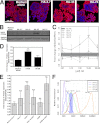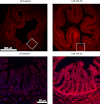Specific-sized hyaluronan fragments promote expression of human β-defensin 2 in intestinal epithelium
- PMID: 22761444
- PMCID: PMC3436307
- DOI: 10.1074/jbc.M112.356238
Specific-sized hyaluronan fragments promote expression of human β-defensin 2 in intestinal epithelium
Abstract
Hyaluronan (HA) is a glycosaminoglycan polymer found in the extracellular matrix of virtually all mammalian tissues. Recent work has suggested a role for small, fragmented HA polymers in initiating innate defense responses in immune cells, endothelium, and epidermis through interaction with innate molecular pattern recognition receptors, such as TLR4. Despite these advances, little is known regarding the effect of fragmented HA at the intestinal epithelium, where numerous pattern recognition receptors act as sentinels of an innate defense response that maintains epithelial barrier integrity in the presence of abundant and diverse microbial challenges. Here we report that HA fragments promote expression of the innate antimicrobial peptide human β-defensin 2 (HβD2) in intestinal epithelial cells. Treatment of HT-29 colonic epithelial cells with HA fragment preparations resulted in time- and dose-dependent up-regulated expression of HβD2 protein in a fragment size-specific manner, with 35-kDa HA fragment preparations emerging as the most potent inducers of intracellular HβD2. Furthermore, oral administration of specific-sized HA fragments promotes the expression of an HβD2 ortholog in the colonic epithelium of both wild-type and CD44-deficient mice but not in TLR4-deficient mice. Together, our observations suggest that a highly size-specific, TLR4-dependent, innate defense response to fragmented HA contributes to intestinal epithelium barrier defense through the induction of intracellular HβD2 protein.
Figures






Similar articles
-
Human milk hyaluronan enhances innate defense of the intestinal epithelium.J Biol Chem. 2013 Oct 4;288(40):29090-104. doi: 10.1074/jbc.M113.468629. Epub 2013 Aug 15. J Biol Chem. 2013. PMID: 23950179 Free PMC article.
-
CD44 and TLR4 mediate hyaluronic acid regulation of Lgr5+ stem cell proliferation, crypt fission, and intestinal growth in postnatal and adult mice.Am J Physiol Gastrointest Liver Physiol. 2015 Dec 1;309(11):G874-87. doi: 10.1152/ajpgi.00123.2015. Epub 2015 Oct 1. Am J Physiol Gastrointest Liver Physiol. 2015. PMID: 26505972 Free PMC article.
-
Stimulation of TLRs by LMW-HA induces self-defense mechanisms in vaginal epithelium.Immunol Cell Biol. 2011 Jul;89(5):630-9. doi: 10.1038/icb.2010.140. Epub 2010 Nov 23. Immunol Cell Biol. 2011. PMID: 21102537
-
The Role of Hyaluronan Treatment in Intestinal Innate Host Defense.Front Immunol. 2020 Apr 29;11:569. doi: 10.3389/fimmu.2020.00569. eCollection 2020. Front Immunol. 2020. PMID: 32411124 Free PMC article. Review.
-
Development, validation and implementation of an in vitro model for the study of metabolic and immune function in normal and inflamed human colonic epithelium.Dan Med J. 2015 Jan;62(1):B4973. Dan Med J. 2015. PMID: 25557335 Review.
Cited by
-
35kDa hyaluronan ameliorates ethanol driven loss of anti-microbial defense and intestinal barrier integrity in a TLR4-dependent manner.Matrix Biol. 2023 Jan;115:71-80. doi: 10.1016/j.matbio.2022.11.008. Epub 2022 Nov 26. Matrix Biol. 2023. PMID: 36574533 Free PMC article.
-
Hyaluronan's Role in Fibrosis: A Pathogenic Factor or a Passive Player?Biomed Res Int. 2015;2015:790203. doi: 10.1155/2015/790203. Epub 2015 Oct 25. Biomed Res Int. 2015. PMID: 26583132 Free PMC article. Review.
-
Hyaluronan - a functional and structural sweet spot in the tissue microenvironment.Front Immunol. 2015 May 15;6:231. doi: 10.3389/fimmu.2015.00231. eCollection 2015. Front Immunol. 2015. PMID: 26029216 Free PMC article. Review.
-
Human milk glycosaminoglycans: the state of the art and future perspectives.Ital J Pediatr. 2013 Jan 15;39:2. doi: 10.1186/1824-7288-39-2. Ital J Pediatr. 2013. PMID: 23321150 Free PMC article.
-
Gamma secretase dependent release of the CD44 cytoplasmic tail upregulates IFI16 in cd44-/- tumor cells, MEFs and macrophages.PLoS One. 2018 Dec 12;13(12):e0207358. doi: 10.1371/journal.pone.0207358. eCollection 2018. PLoS One. 2018. PMID: 30540779 Free PMC article.
References
-
- Turner J. R. (2009) Intestinal mucosal barrier function in health and disease. Nat. Rev. Immunol. 9, 799–809 - PubMed
-
- Underwood M. A., Bevins C. L. (2010) Defensin-barbed innate immunity. Clinical associations in the pediatric population. Pediatrics 125, 1237–1247 - PubMed
-
- Menendez A., Brett Finlay B. (2007) Defensins in the immunology of bacterial infections. Curr. Opin. Immunol. 19, 385–391 - PubMed
-
- Seo E. S., Vargues T., Clarke D. J., Uhrín D., Campopiano D. J. (2009) Preparation of isotopically labeled recombinant β-defensin for NMR studies. Protein Expr. Purif. 65, 179–184 - PubMed
-
- Zasloff M. (2002) Antimicrobial peptides of multicellular organisms. Nature 415, 389–395 - PubMed
Publication types
MeSH terms
Substances
Grants and funding
LinkOut - more resources
Full Text Sources
Other Literature Sources
Medical
Molecular Biology Databases
Miscellaneous

